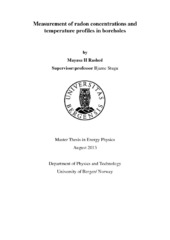| dc.description.abstract | This thesis is based on a research project aimed at measuring temperature gradients and radon concentrations in boreholes. This was done by observing radon activity and temperature profiles in twelve boreholes that were investigated between October 2012 and May 2013. The boreholes located in Bergen and Osterøy were drilled for extracting underground heat by means of heat pumps and heat exchangers at shallow depths. Underground heat flow results from the decay process of radioactive elements such as U-235, U-238, Th-232, and K-40 with high concentrations in granitic rocks. Using this the total energy of decay chain of U-238 to Pb-208 was calculated to understand how much energy located in the ground was due to uranium. Temperature profiles were measured in bore holes by means of sensitive temperature sensors. The logger reads temperature in 10 second intervals. Samples were recorded for 60 and 30 sec at each depth (5 m). The time however was not long enough for the logger to have stable temperature readings. Therefore, the temperature logger calibration was performed for an unbiased estimate of the temperature at each depth. The logger was placed in a container full of ice water for 15 minutes. Obtained calibration data were plotted on the same figure with the measured data. Figures show in total a variation in some points near the surface. Radon calibration by using a canary meter with a radioactive source and coalboxes sealed in a plastic box for three days at the laboratory room was used to determine the calibration constant K to be used in field measurements. Energy calibration was done in order to convert the channel number to energy by using known energy values of isotopes such as Cs-137, Na-22, and Ra-226 to determine the energy for unknown sources. Radon concentration was detected by placing coal boxes on top of boreholes in order to absorb radon gas. They were left for three days because the half-life of radon is about three days. The coal boxes were then placed in a gamma ray detector for gamma spectroscopy. Clear peaks were noted from area 2 bore holes, which indicates high radon concentration emanated from boreholes in such area. Results shown in this thesis were taken from twelve water boreholes: four 250 m deep holes at the Haukeland university hospital (area1), three 180 m deep holes in Osterøy (area2), four 210 m deep holes in Åsane (area3), and one 500 m deep hole in Fyllingsdalen (area4) Thermal studies show no variation between bore holes, whereas radon concentration is hole dependent. No significant correlation was observed between thermal energy and radon concentration. The next few chapters in this thesis are presenting the results of the Rn-222 concentration and temperature data in boreholes. | en_US |
